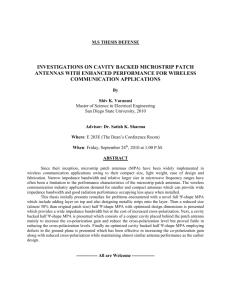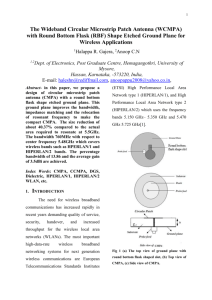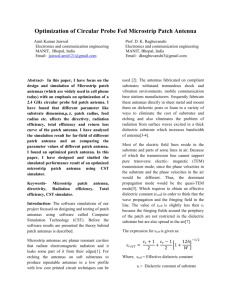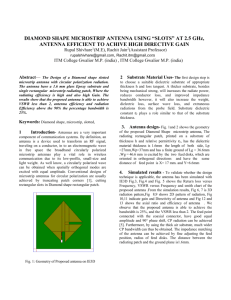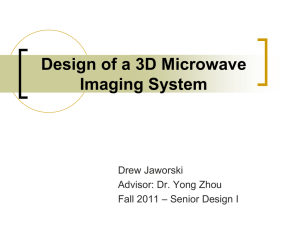Micro strip Patch Antenna
advertisement
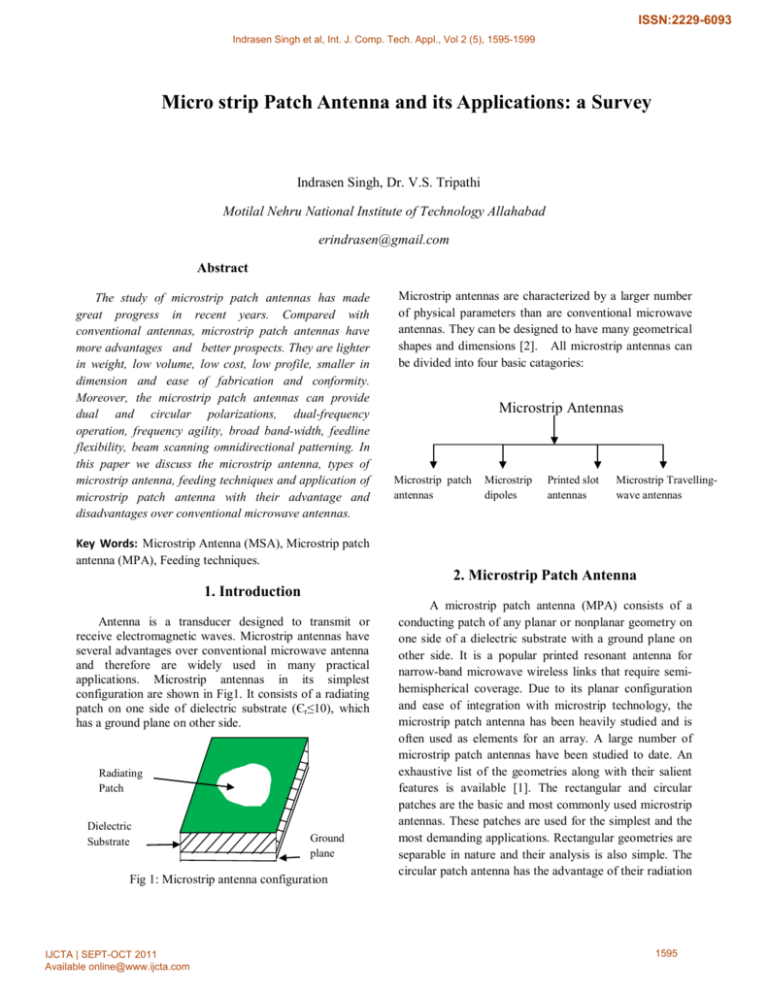
ISSN:2229-6093 Indrasen Singh et al, Int. J. Comp. Tech. Appl., Vol 2 (5), 1595-1599 Micro strip Patch Antenna and its Applications: a Survey Indrasen Singh, Dr. V.S. Tripathi Motilal Nehru National Institute of Technology Allahabad erindrasen@gmail.com Abstract The study of microstrip patch antennas has made great progress in recent years. Compared with conventional antennas, microstrip patch antennas have more advantages and better prospects. They are lighter in weight, low volume, low cost, low profile, smaller in dimension and ease of fabrication and conformity. Moreover, the microstrip patch antennas can provide dual and circular polarizations, dual-frequency operation, frequency agility, broad band-width, feedline flexibility, beam scanning omnidirectional patterning. In this paper we discuss the microstrip antenna, types of microstrip antenna, feeding techniques and application of microstrip patch antenna with their advantage and disadvantages over conventional microwave antennas. Microstrip antennas are characterized by a larger number of physical parameters than are conventional microwave antennas. They can be designed to have many geometrical shapes and dimensions [2]. All microstrip antennas can be divided into four basic catagories: Microstrip Antennas Microstrip patch antennas Microstrip dipoles Printed slot antennas Microstrip Travellingwave antennas Key Words: Microstrip Antenna (MSA), Microstrip patch antenna (MPA), Feeding techniques. 2. Microstrip Patch Antenna 1. Introduction Antenna is a transducer designed to transmit or receive electromagnetic waves. Microstrip antennas have several advantages over conventional microwave antenna and therefore are widely used in many practical applications. Microstrip antennas in its simplest configuration are shown in Fig1. It consists of a radiating patch on one side of dielectric substrate (Єr≤10), which has a ground plane on other side. Radiating Patch Dielectric Substrate Ground plane Fig 1: Microstrip antenna configuration IJCTA | SEPT-OCT 2011 Available online@www.ijcta.com A microstrip patch antenna (MPA) consists of a conducting patch of any planar or nonplanar geometry on one side of a dielectric substrate with a ground plane on other side. It is a popular printed resonant antenna for narrow-band microwave wireless links that require semihemispherical coverage. Due to its planar configuration and ease of integration with microstrip technology, the microstrip patch antenna has been heavily studied and is often used as elements for an array. A large number of microstrip patch antennas have been studied to date. An exhaustive list of the geometries along with their salient features is available [1]. The rectangular and circular patches are the basic and most commonly used microstrip antennas. These patches are used for the simplest and the most demanding applications. Rectangular geometries are separable in nature and their analysis is also simple. The circular patch antenna has the advantage of their radiation 1595 ISSN:2229-6093 Indrasen Singh et al, Int. J. Comp. Tech. Appl., Vol 2 (5), 1595-1599 pattern being symmetric. A rectangular microstrip patch antenna in its simplest form is shown in Figure 2. III. Feeding Techniques A feedline is used to excite to radiate by direct or indirect contact. There are many different techniques of feeding and four most popular techniques are coaxial probe feed, microstrip line, aperture coupling and proximity coupling [2]. L Patch W t Coaxial probe feeding is feeding method in which that the inner conductor of the coaxial is attached to the radiation patch of the antenna while the outer conductor is connected to the ground plane. Advantages of coaxial feeding is easy of fabrication, easy to match, low spurious radiation and its disadvantages is narrow bandwidth, Difficult to model specially for thick substrate. Patch antenna h Dielectric Substrate Ground Plane Fig 2: Structure of rectangular microstrip patch antenna h Substrate Ground Plane The characteristics of microstrip patch antennas, microstrip sot antennas and printed dipole antennas are compared in table 1. Sr. No . Characteristics 1. 2. Profile Fabrication 3. Polarization 4. DualFrequency operation Shape flexibility 5. 6. 7. Spurious radiation Bandwidth Microstri p Patch Antenna Thin Very easy Both linear and circular Possible Microstrip Slot Antenna Printed Diopole antenna Thin Easy Thin Easy Both linear and circular Linear Possible Possible Any shape Mostly rectangular and circular shapes Exists Rectangulat ar and triangular Exists 2-50% 5-30% Coaxial Cable Fig 3: Coexial probe feed patch antenna Microstrip line feed is one of the easier methods to fabricate as it is a just conducting strip connecting to the patch and therefore can be consider as extension of patch. It is simple to model and easy to match by controlling the inset position. However the disadvantage of this method is that as substrate thickness increases, surface wave and spurious feed radiation increases which limit the bandwidth. L λ/4 Exists -30% Microstrip line Z0 Microstrip Antenna W Z1 Єr ] Substrate Fig 4: Microstrip line feed patch antenna IJCTA | SEPT-OCT 2011 Available online@www.ijcta.com 1596 ISSN:2229-6093 Indrasen Singh et al, Int. J. Comp. Tech. Appl., Vol 2 (5), 1595-1599 Aperture coupled feed consist of two different substrate separated by a ground plane. On the bottom side of lower substrate there is a microstrip feed line whose energy is coupled to the patch through a slot on the ground plane separating two substrates. This arrangement allows independent optimization of the feed mechanism and the radiating element. Normally top substrate uses a thick low dielectric constant substrate while for the bottom substrate; it is the high dielectric substrate. The ground plane, which is in the middle, isolates the feed from radiation element and minimizes interference of spur ious radiation for pattern formation and polarization purity. Advantages is allows independent optimization of feed mechanism element. Єr2 Єr1 Transmission Line Fig 5: Aperture coupled feed patch antenna Proximity coupling has the largest bandwidth, has low spurious radiation. However fabrication is difficult. Length of feeding stub and width-to-length ratio of patch is used to control the match. Its coupling mechanism is capacitive in nature. Patch Antenna dielectric Microstrip feed line Feed substrate Fig 6: Proximity coupled microstrip patch antenna The major disadvantage of this feeding technique is that it is difficult to fabricate because of the two dielectric IJCTA | SEPT-OCT 2011 Available online@www.ijcta.com In the wide range of antenna models there are different structures of Microstrip antennas, but on the whole we have four basic parts in the antenna [6]: They are: - The patch - Dielectric Substrate - Ground Plane - Feed Line 4. Applications Patch Antenna Ground plane with aperture layers that need proper alignment. Also there is increase in overall thickness of the antenna. The Microstrip patch antennas are well known for their performance and their robust design, fabrication and their extent usage. The advantages of this Microstrip patch antenna are to overcome their de-merits such as easy to design, light weight etc., the applications are in the various fields such as in the medical applications, satellites and of course even in the military systems just like in the rockets, aircrafts missiles etc. the usage of the Microstrip antennas are spreading widely in all the fields and areas and now they are booming in the commercial aspects due to their low cost of the substrate material and the fabrication. It is also expected that due to the increasing usage of the patch antennas in the wide range this could take over the usage of the conventional antennas for the maximum applications. Microstrip patch antenna has several applications. Some of these applications are discussed as below: Mobile and satellite communication application: Mobile communication requires small, low-cost, low profile antennas. Microstrip patch antenna meets all requirements and various types of microstrip antennas have been designed for use in mobile communication systems. In case of satellite communication circularly polarized radiation patterns are required and can be realized using either square or circular patch with one or two feed points. Global Positioning System applications: Nowadays microstrip patch antennas with substrate having high permittivity sintered material are used for global positioning system. These antennas are circularly polarized, very compact and quite expensive due to its positioning. It is expected that millions of GPS receivers will be used by the general population for land vehicles, aircraft and maritime vessels to find there position accurately 1597 ISSN:2229-6093 Indrasen Singh et al, Int. J. Comp. Tech. Appl., Vol 2 (5), 1595-1599 Radio Frequency Identification (RFID): RFID uses in different areas like mobile communication, logistics, manufacturing, transportation and health care [2]. RFID system generally uses frequencies between 30 Hz and 5.8 GHz depending on its applications. Basically RFID system is a tag or transponder and a transceiver or reader. Worldwide Interoperability for Microwave Access (WiMax): The IEEE 802.16 standerd is known as WiMax. It can reach upto 30 mile radius theoretically and data rate 70 Mbps. MPA generates three resonant modes at 2.7, 3.3 and 5.3 GHz and can, therefore, be used in WiMax compliant communication equipment. Radar Application: Radar can be used for detecting moving targets such as people and vehicles. It demands a low profile, light weight antenna subsystem, the microstrip antennas are an ideal choice. The fabrication technology based on photolithography enables the bulk production of microstrip antenna with repeatable performance at a lower cost in a lesser time frame as compared to the conventional antennas. Rectenna Application: Rectenna is a rectifying antenna, a special type of antenna that is used to directly convert microwave energy into DC power. Rectenna is a combination of four subsystems i.e. Antenna, ore rectification filter, rectifier, post rectification filter. in rectenna application, it is necessary to design antennas with very high directive characteristics to meet the demands of long-distance links. Since the aim is to use the rectenna to transfer DC power through wireless links for a long distance, this can only be accomplished by increasing the electrical size of the antenna. Telemedicine Application: In telemedicine application antenna is operating at 2.45 GHz. Wearable microstrip antenna is suitable for Wireless Body Area Network (WBAN). The proposed antenna achieved a higher gain and front to back ratio compared to the other antennas, in addition to the semi directional radiation pattern which is preferred over the omni-directional pattern to overcome unnecessary radiation to the user's body and satisfies the requirement for on-body and off-body applications. A antenna having gain of 6.7 dB and a F/B ratio of 11.7 dB and resonates at 2.45GHz is suitable for telemedicine applications. hyperthermia. The design of the particular radiator which is to be used for this purpose should posses light weight, easy in handling and to be rugged. Only the patch radiator fulfils these requirements. The initial designs for the Microstrip radiator for inducing hyperthermia was based on the printed dipoles and annular rings which were designed on S-band. And later on the design was based on the circular microstrip disk at L-band. There is a simple operation that goes on with the instrument; two coupled Microstrip lines are separated with a flexible separation which is used to measure the temperature inside the human body. A flexible patch applicator can be seen in the figure below which operates at 430 MHz. V. Advantage and Disadvantage Microstrip patch antenna has several advantages over conventional microwave antenna with one similarity of frequency range from 100 MHz to 100 GHz same in both type. The various advantage and disadvantage are given in table 2. Sr. No. Advantage Disadvantage 1. Low weight Low efficiency 2. Low profile Low gain 3. Thin profile Large ohmic loss in the feed structure of arrays 4. Required no cavity backing Low power capacity 5. Linear circulation polarization Excitation waves 6. Capable of dual and triple frequency operation Polarization pur ity difficult to achieve 7. Feed lines and matching network can be fabricated simultaneously Complex feed structures require high performance arrays and of handling surface Medicinal applications of patch: It is found that in the treatment of malignant tumors the microwave energy is said to be the most effective way of inducing IJCTA | SEPT-OCT 2011 Available online@www.ijcta.com 1598 is ISSN:2229-6093 Indrasen Singh et al, Int. J. Comp. Tech. Appl., Vol 2 (5), 1595-1599 5. Conclusion A theoretical survey on microstrip patch antenna is presented in this paper. Some effect of disadvantages can be minimized. Lower gain and low power handling capacity can be overcome through an array configuration. Some factors are involved in the selection of feeding technique. Particular microstrip patch antenna can be designed for each application and different merits are compared with conventional microwave antenna. 12. References [1] James j., and P.S. Hall (Eds), Handbook of microstrip antenna, Peter Peregrinus, London, UK, 1989. [2] Ramesh Garg, Prakash Bartia, Inder Bahl, Apisak Ittipiboon, ‘’Microstrip Antenna Design Handbook’’, 2001, pp 1‐68, 253‐316 Artech House Inc. Norwood, MA. [3] Wentworth M. Stuart (2005), ‘’Fundamentals of Electromagnetic with Engineering Applications’’, pp 442‐445, John Wiley & Sons, NJ, USA. [4] J. D. Kraus, R. J. Marhefka, “Antenna for all applications” 3rd Ed., McGraw- Hill, 2002. [5] Robert A. Sainati, CAD of Microstrip Antennas for Wireless Applications, Artech House Inc, Norwood, MA, 1996. [6] Y T Lo and S W Lee, editors, ‘’Antenna Handbook Theory, Applications & Design’’, Van Nostrand Rein Company, NY, 1988. [7] C.A. Balanis, Antenna theory: analysis and design, 2nd ed., John Willey and & Son, Inc., 1997. IJCTA | SEPT-OCT 2011 Available online@www.ijcta.com 1599
